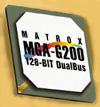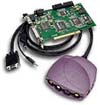Video Card
Page
Description:
Video cards provide the means
for the computer to "talk" to your monitor so it can display what the
computer is doing. Video cards can be "2D," "3D," or
"2D/3D" combos. The 3D is mostly useful for gaming, but in some
applications can be useful in 3D modeling, etc. Of course, it is best if
you can find a good 2D/3D combo card instead of buying two different video cards
(which is really only needed for avid gamers like myself). Fortunately,
some companies are beginning to come out with high quality video cards that will
do both 2D and 3D very well. Currently, all new video cards are designed
with 3D capabilities, but of course some are better than others.
What To Look For:
There are a great deal of
variations in video cards and many different things to look for. I will
only discuss some of them, particularly the more basic ones.
Do you want an AGP or PCI
video card? This should be decided easily by whether or not you have an
AGP port on your motherboard. Most Pentium II motherboards do have an AGP
port. If you have one, get an AGP card, if not, get a PCI card. AGP stands
for Accelerated Graphics Port and allows for faster transfers to the video card.
The video card is also given a direct connection to system memory.
The chipset is what controls
the video card's operation. The latest chipsets are designed to do both 2D
and 3D. Quality chipsets to look for are Riva TNT2, Matrox's G400 chipset,
ATI's Rage Fury MAXX, 3Dfx VooDoo3, and the GeForce.
Amount of memory on the card
is very important. It can affect the speed of operation as well as the
number of colors and resolution size that can be used. At least 4 MB is
needed now, but 8 or more is recommended. Some video cards (like the Riva
cards and AGP cards in particular) use system memory so that the video card
memory is not quite as important. The type of memory is also important.
Matrox's WRAM is very fast as is VRAM.
*Update* SGRAM and SDRAM have become somewhat standard in the most recent video
cards. While the other RAM is faster, it is also more expensive and not
used much anymore.
32 MB of RAM should be your target on a video card now. That's become the
most common amount.
The supported resolutions and
colors are important if you want to run at higher resolutions with a large
number of colors.
Refresh Rate determines how
fast the video card can refresh (redraw on the screen) your display. The
higher the better. Pay attention to what resolutions it has the high
refresh rates at. Make sure your monitor
supports these resolutions and refresh rates as well.
Some other things to consider
are TV-Out, TV-In, video capture capabilities, the speed of the RAM DAC (230 MHz
or higher is good), 3D effects that are supported, whether or not technologies
such as OpenGL and DirectX7, and what software the video card comes with.
Recommendations:
- 6/16/00
Update -- The everchanging video card industry has another new king - now
it's the GeForce GTS (GeForce II). Nothing else is
really even worth considering, unless price is a concern. In that
case, another of Nvidia's cards will do nicely (a TNT2 or TNT2 Ultra).
3Dfx does have their new VooDoo 5500, 6000 coming out soon though. It
looks like these cards still don't beat the GeForce in raw speed (despite
being so power hungry they require their own power supply), but 3Dfx
surprisingly now hold the edge in image quality. Is it that much
better? That's tough to decide. My recommendation is currently
for the GeForce 2 (which is easier to get your hands on currently). Go
for the Hercules or Asus brand cards. In particular, the
Hercules 3D Prophet II GTS with 64 MB DDR RAM, is tough to beat! To
save money, you may want to go with the 32 MB version.
- 4/24/00
Update -- If you have the money burning a hole in your pocket, then you may
want to go with a 64 MB GeForce card (Asus 6800 preferably), but for those
of us that are more practical, consider sticking with a 32 MB LeadTek
WinFast GeForce 256 DDR. In addition to great performance out of the
box, this card is designed with great cooling, allowing for high
overclocking speeds (make sure you look for the newer Revision B of this
card).
Also, Nvidia's NV15 is just around the corner, so instead of dropping a wad
of cash for the greatest now (a 64 MB GeForce), save your money for the
NV15, which may dwarf the GeForce! I wouldn't suggest spending your
money on a VooDoo 5; I expect the NV15 to be better overall.
- 3/1/00
Update- Current recommendations below still hold. DDR versions of the
GeForce cards are now available, so I would recommend getting one of them if
you can afford the price difference. My best pick is the Creative
Labs Annihilator Pro DDR.
11/13/99 Update- The Nvidia GeForce is the king of speed, overtaking
the Matrox G400 MAX. But which is best for you? The G400
offers superb image quality and great features like dual monitor support and
hardware bump mapping. The GeForce also offers good image quality and
sheer power. Currently, it's a tough choice between these cards, and there's
more on the horizon.
The ATI Rage Fury MAXX may soon be a powerful contender as well. My
experience with ATI has not been very good, but who knows, this card may
turn out great. The S3 Savage 2000 is also looking good, but not as
good as the GeForce. Nvidia also has a new chip in the making that
should beat all of the above, but you'll have to wait awhile for it...
If you opt for a GeForce, the Guillemot 3D Prophet looks like the best so
far and boasts 32 MB RAM and Video out. The DDR version is even faster
with DDR RAM.
- 10/10/99
Update- TNT2 Ultras were the king, but no more! I'm happy to say that
the Matrox G400 MAX has beaten the king! They have always had the
better image and features, now they have the better speed too! I
strongly suggest getting this card over any other at this point in time.
However, the Nvidia GeForce is coming out soon and will probably beat the
G400 MAX in speed. Whether or not it's worth waiting for is up to you.
- 9/1/99
Update- Any of the video cards based on the Riva TNT2 Ultra chipset are
simply the best right now. Here's a brief list of some of the
different companies that have made a card based on the TNT2 Ultra chipset,
in my order of preference (for the most part, they are all equal or very
close to it):
- Asus
(Deluxe = great features - video in & out, slightly slower RAM)
- Hercules
(very high speed, high speed RAM, but possibly unreliable)
- Guillemot
(cheap, high quality & speed)
- Diamond
- Creative
Labs
- The
Matrox Millenium G400 is a great card, but I would suggest waiting a little
while and
 getting the MAX version. The image quality with this card is
absolutely incredible (even better than the TNT2s). The speed is
somewhat slower than the TNT2 Ultras, so I picked them as #1. The
getting the MAX version. The image quality with this card is
absolutely incredible (even better than the TNT2s). The speed is
somewhat slower than the TNT2 Ultras, so I picked them as #1. The
- The
VooDoo3 cards are fast, but that's all. The image quality just isn't
present... :(
-
*Update* The Riva TNT, Matrox G200, Intel i-740, and Riva 128 are some
older, good quality video cards for someone on a tight budget. They
are listed above in order of my preference in terms of speed and image
quality. The TNT in particular is still a good
 video card in 2D, 3D, image quality, and speed.
video card in 2D, 3D, image quality, and speed.
-
If you just want to add some 3D capabilities to your current computer, the
3Dfx VooDoo2 3D add-on cards may be appropriate. They will give you
good speed, but don't have the image quality or speed of the newer video
cards.
-
 As
an aside, for the best value video capture card, consider the Iomega Buzz
(though it is NOT a video card, only used for video capture). It does
great video capture (for the price) and comes with a Narrow (50-pin) SCSI
card too.
As
an aside, for the best value video capture card, consider the Iomega Buzz
(though it is NOT a video card, only used for video capture). It does
great video capture (for the price) and comes with a Narrow (50-pin) SCSI
card too.
 getting the MAX version. The image quality with this card is
absolutely incredible (even better than the TNT2s). The speed is
somewhat slower than the TNT2 Ultras, so I picked them as #1. The
getting the MAX version. The image quality with this card is
absolutely incredible (even better than the TNT2s). The speed is
somewhat slower than the TNT2 Ultras, so I picked them as #1. The  video card in 2D, 3D, image quality, and speed.
video card in 2D, 3D, image quality, and speed.  As
an aside, for the best value video capture card, consider the Iomega Buzz
(though it is NOT a video card, only used for video capture). It does
great video capture (for the price) and comes with a Narrow (50-pin) SCSI
card too.
As
an aside, for the best value video capture card, consider the Iomega Buzz
(though it is NOT a video card, only used for video capture). It does
great video capture (for the price) and comes with a Narrow (50-pin) SCSI
card too.